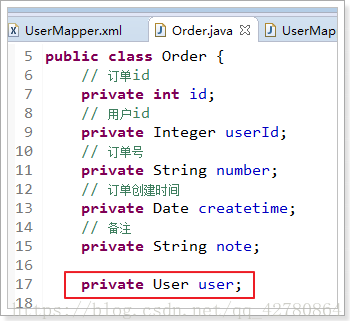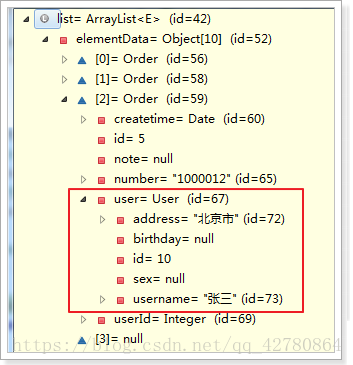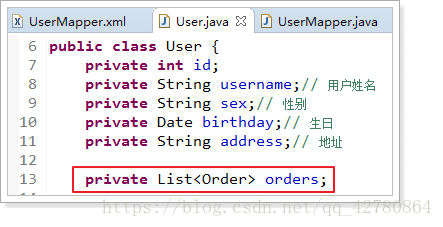resultType
resultType可以把查询结果封装到pojo类型中,但必须pojo类的属性名和查询到的数据库表的字段名一致。
如果sql查询到的字段与pojo的属性名不一致,则需要使用resultMap将字段名和属性名对应起来,进行手动配置封装,将结果映射到pojo中
resultMap
resultMap可以实现将查询结果映射为复杂类型的pojo,比如在查询结果映射对象中包括pojo和list实现一对一查询和一对多查询。

先在Mapper文件中,配置基本的sql语句
<!-- 查询所有的订单数据 -->
<!-- resultMap:填入配置的resultMap标签的id值 -->
<select id="queryOrderAll" resultMap="orderResultMap">
SELECT id, user_id,
number,
createtime, note FROM `order`
</select>
配置resultMap标签,映射不同的字段和属性名
<!-- resultMap最终还是要将结果映射到pojo上,type就是指定映射到哪一个pojo -->
<!-- id:设置ResultMap的id -->
<resultMap type="order" id="orderResultMap">
<!-- 定义主键 ,非常重要。如果是多个字段,则定义多个id -->
<!-- property:主键在pojo中的属性名 -->
<!-- column:主键在数据库中的列名 -->
<id property="id" column="id" />
<!-- 定义普通属性 -->
<result property="userId" column="user_id" />
<result property="number" column="number" />
<result property="createtime" column="createtime" />
<result property="note" column="note" />
</resultMap>
结果就可以封装到pojo类型中
使用resultMap进行关联查询
一对一查询
一对一数据模型:订单用户
一个订单信息只会是一个人下的订单,所以从查询订单信息出发关联查询用户信息为一对一查询。如果从用户信息出发查询用户下的订单信息则为一对多查询,因为一个用户可以下多个订单。

改造pojo类
在订单类中添加User属性,User属性是一个引用类型,用于存储关联查询的用户信息,因为关联关系是一对一,所以只需要添加单个属性即可

配置Mapper.xml配置文件
OrderMapper.xml
先使用id和result属性,映射order类的结果集,然后在使用association映射关联对象User的结果集
<resultMap type="order" id="orderUserResultMap">
<id property="id" column="id" />
<result property="userId" column="user_id" />
<result property="number" column="number" />
<result property="createtime" column="createtime" />
<result property="note" column="note" />
<!-- association :配置一对一属性 -->
<!-- property:order里面的User属性名 -->
<!-- javaType:属性类型 -->
<association property="user" javaType="user">
<!-- id:声明主键,表示user_id是关联查询对象的唯一标识-->
<id property="id" column="user_id" />
<result property="username" column="username" />
<result property="address" column="address" />
</association>
</resultMap>
<!-- 一对一关联,查询订单,订单内部包含用户属性 -->
<select id="queryOrderUserResultMap" resultMap="orderUserResultMap">
SELECT
o.id,
o.user_id,
o.number,
o.createtime,
o.note,
u.username,
u.address
FROM
`order` o
LEFT JOIN `user` u ON o.user_id = u.id
</select>
测试
@Test
public void testQueryOrderUserResultMap() {
// mybatis和spring整合,整合之后,交给spring管理
SqlSession sqlSession = this.sqlSessionFactory.openSession();
// 创建Mapper接口的动态代理对象,整合之后,交给spring管理
UserMapper userMapper = sqlSession.getMapper(UserMapper.class);
// 使用userMapper执行根据条件查询用户,结果封装到Order类中
List<Order> list = userMapper.queryOrderUserResultMap();
for (Order o : list) {
System.out.println(o);
}
// mybatis和spring整合,整合之后,交给spring管理
sqlSession.close();
}
结果

一对多查询
配置resultMap标签,映射不同的字段和属性名
<!-- resultMap最终还是要将结果映射到pojo上,type就是指定映射到哪一个pojo --> <!-- id:设置ResultMap的id --> <resultMap type="order" id="orderResultMap"> <!-- 定义主键 ,非常重要。如果是多个字段,则定义多个id --> <!-- property:主键在pojo中的属性名 --> <!-- column:主键在数据库中的列名 --> <id property="id" column="id" />
<!-- 定义普通属性 --> <result property="userId" column="user_id" /> <result property="number" column="number" /> <result property="createtime" column="createtime" /> <result property="note" column="note" /> </resultMap>1234567891011121314
————————————————版权声明:本文为CSDN博主「正在努力的陈序员」的原创文章,遵循CC 4.0 BY-SA版权协议,转载请附上原文出处链接及本声明。原文链接:https://blog.csdn.net/qq_42780864/article/details/81429114

